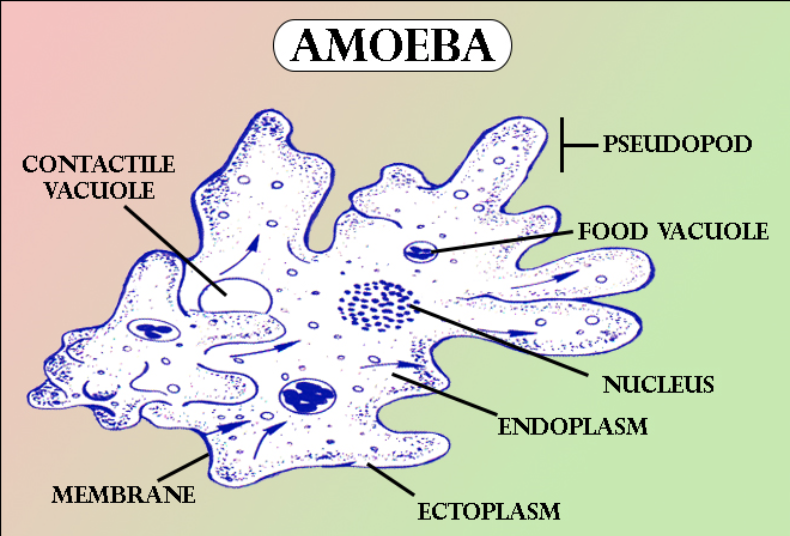
Answer
441k+ views
Hint: Osmoregulation is the active control of the osmotic pressure of the body fluids of an organism, sensed by osmoreceptors, to maintain the homeostasis of the water content of the organism; that is, it maintains the fluid balance and the electrolyte concentration (salts in solution defined by body fluid in this case) to prevent the fluids of the body from being too diluted or concentrated.
Complete answer:
- Protists like Amoeba and Paramecium make use of contractile vacuoles to collect excretory wastes, such as ammonia, from the intracellular fluid by diffusion and active transport. As osmotic action pushes water from the environment into the cytoplasm, the vacuole moves to the surface and pumps the contents into the environment.

- Amoeba lives in freshwater as well as a marine; the freshwater amoeba has contractile vacuole for essential osmoregulation. The water reaches the body from the general surface of the body via endosmosis. The different solute concentration within the amoeba body and the less solute concentration in freshwater allow the water to travel inside the organism towards the hypertonic environment. Here, the contractile vacuole eliminates the excess water inside the body.
- Osmotic pressure is a measure of water's ability to shift through osmosis into one solution from another. The higher a solution's osmotic pressure, the more water appears to flow into it.
- Pressure must be exerted on the hypertonic side of the selectively permeable membrane in order to avoid osmosis water diffusion from the pure water containing side.
So, the correct answer is ‘Contractile vacuole’.
Note:
- Osmoregulation, respiration, and excretion are involved in the contractile vacuole.
- The contractile vacuole absorbs this water along with the water that is taken in during food intake.
- A contractile vacuole has a diameter of around $20\mu m -30\mu m$ and contains accumulated fluid which is less dense than the cytoplasm surrounding it.
Complete answer:
- Protists like Amoeba and Paramecium make use of contractile vacuoles to collect excretory wastes, such as ammonia, from the intracellular fluid by diffusion and active transport. As osmotic action pushes water from the environment into the cytoplasm, the vacuole moves to the surface and pumps the contents into the environment.

- Amoeba lives in freshwater as well as a marine; the freshwater amoeba has contractile vacuole for essential osmoregulation. The water reaches the body from the general surface of the body via endosmosis. The different solute concentration within the amoeba body and the less solute concentration in freshwater allow the water to travel inside the organism towards the hypertonic environment. Here, the contractile vacuole eliminates the excess water inside the body.
- Osmotic pressure is a measure of water's ability to shift through osmosis into one solution from another. The higher a solution's osmotic pressure, the more water appears to flow into it.
- Pressure must be exerted on the hypertonic side of the selectively permeable membrane in order to avoid osmosis water diffusion from the pure water containing side.
So, the correct answer is ‘Contractile vacuole’.
Note:
- Osmoregulation, respiration, and excretion are involved in the contractile vacuole.
- The contractile vacuole absorbs this water along with the water that is taken in during food intake.
- A contractile vacuole has a diameter of around $20\mu m -30\mu m$ and contains accumulated fluid which is less dense than the cytoplasm surrounding it.
Recently Updated Pages
Who among the following was the religious guru of class 7 social science CBSE

what is the correct chronological order of the following class 10 social science CBSE

Which of the following was not the actual cause for class 10 social science CBSE

Which of the following statements is not correct A class 10 social science CBSE

Which of the following leaders was not present in the class 10 social science CBSE

Garampani Sanctuary is located at A Diphu Assam B Gangtok class 10 social science CBSE

Trending doubts
A rainbow has circular shape because A The earth is class 11 physics CBSE

Which are the Top 10 Largest Countries of the World?

Fill the blanks with the suitable prepositions 1 The class 9 english CBSE

Which of the following was the capital of the Surasena class 6 social science CBSE

How do you graph the function fx 4x class 9 maths CBSE

The Equation xxx + 2 is Satisfied when x is Equal to Class 10 Maths

Give 10 examples for herbs , shrubs , climbers , creepers

Difference between Prokaryotic cell and Eukaryotic class 11 biology CBSE

Who was the first Director General of the Archaeological class 10 social science CBSE




